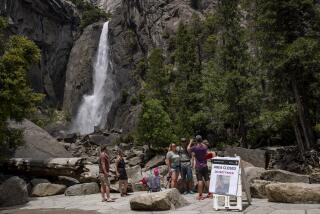After Staff’s Mighty Efforts, Yosemite Ready for Season
- Share via
A few weeks ago in this space, I gently suggested that after the ravages of last winter’s floods in Yosemite, this might be a good summer to bypass that park and consider another. And who knows? Maybe somebody will.
But granite canyon walls, oak groves and tall waterfalls speak more persuasively than words. Thousands of travelers have made their summer bookings for Yosemite National Park, and concessionaires and National Park Service workers have labored mightily to get the park back into shape.
The park’s overnight guest capacity has been cut by 20%, spring visitation figures are showing a decline of about 30%, and various other services have been limited. For instance, the stables in Yosemite Valley are closed. But park officials and concessions operators managed to reopen Yosemite Valley on March 14, after 73 days closed. And despite the worries expressed in the aftermath of the January flooding--when more than six inches of rain fell in three days--this summer in many ways will amount to business as usual.
One example: After raising the prospect of required reservations for day-use visitors, park officials decided March 27 not to put such a system in place. That means park officials will have less advance control over crowding in Yosemite Valley, but that life will remain less complicated for those who drive in by day--unless a capacity crowd leads officials to limit access, as has happened on busy days in years past.
For those who plan to be a part of Yosemite this summer, here are a few tips from the National Park Service and Yosemite concessionaires.
* Be ready to pay more than you did on your last visit. Under a pilot program intended to return more revenue to individual parks, Yosemite on Jan. 1 boosted its entrance fee from $5 to $20 per car. Visitors on foot or bicycle pay $10 each. Those fee hikes notwithstanding, you can expect summer crowds in Yosemite Valley, especially on weekends. With their habits shaped by school vacations, about 70% of the park’s 4.1 million visitors last year arrived from May through October.
* Bring a camera. The same storms that brought an estimated $176 million in damages over the winter--damages that will require three to four years to repair--can be thanked for a scenic and thunderous waterfall runoff likely to last through the summer and into the fall. Though many popular trails nearby remain closed because of either snowpack or flood damage, many others are open or due to open soon. (For a more specific update, hikers can call the trail number below.)
* Two of the park’s major access roads, California 41 from the south and California 120 from the west, are open. California 140 from Merced via Mariposa, a third popular entry, is open, with convoys scheduled.
* Be flexible. Even before this month began, park officials were saying that just about the only summertime space they had left was in canvas tent cabins. At Yosemite Lodge, 246 of the 495 rooms and cabins will be out of service this summer. The 628 wood cabins, canvas tent cabins and hotel rooms of Curry Village are open, though as many as 50 to 70 may be occupied by concession employees this summer. Sixteen of the Housekeeping Camp’s 282 units have been demolished--not as a result of flooding, but under long-term plans to reduce human impact in the valley. The 123-room Ahwahnee and 104-room Wawona hotels are fully open (and just about fully booked). Booking now, your best bet is either a Housekeeping unit (where you can cook) or one of Curry Village’s more than 420 canvas tent cabins (maid service, shared bathrooms, about $40 to $45 nightly, but no cooking). Another alternative is lodging outside park boundaries.
* The park’s inventory of campsites has shrunk from about 1,800 to about 1,400. Most notable losses: All 126 campsites of the Lower River campground alongside the Merced River and all 124 of the Upper River campground. At the Lower Pines campground, rangers expect the inventory of 172 sites to shrink to fewer than 80.
* If you’re calling the park’s lodging reservations line (see numbers below), try to do it on Saturday or Sunday, when caller traffic is lightest. (On weekdays, the wait on hold for a reservation clerk can be as long as five minutes.) And have alternative travel dates in mind, in case no accommodations are available on your dates of first choice.
* If at first you don’t succeed in getting your lodgings of choice, keep in mind that some openings will develop as reservation payment deadlines come up. Thus, if you call 30 days before your arrival, and 15 and seven days before, you may be able to move your booking to a room that was unavailable when you first called.
* For an overview of the park, and information on possibilities you hadn’t even considered (want to work in the park for a summer?), have a look at the park concessionaire’s new Web site. Unveiled April 17, it can be found at https://www.yosemitepark.com. The National Park Service also includes Yosemite as part of its Web site at https://www.nps.gov/yose.
For more detailed information, here are some useful Yosemite numbers:
Lodging reservations: (209) 252-4848.
Campgrounds: (800) 436-7275.
Roads and trails: (209) 372-0200.
General information: (209) 372-1000.
Reynolds travels anonymously at the newspaper’s expense, accepting no special discounts or subsidized trips. He welcomes comments and suggestions, but cannot respond individually to letters and calls. Write Travel Insider, Los Angeles Times, Times Mirror Square, Los Angeles 90053 or e-mail [email protected].
More to Read
Sign up for The Wild
We’ll help you find the best places to hike, bike and run, as well as the perfect silent spots for meditation and yoga.
You may occasionally receive promotional content from the Los Angeles Times.







